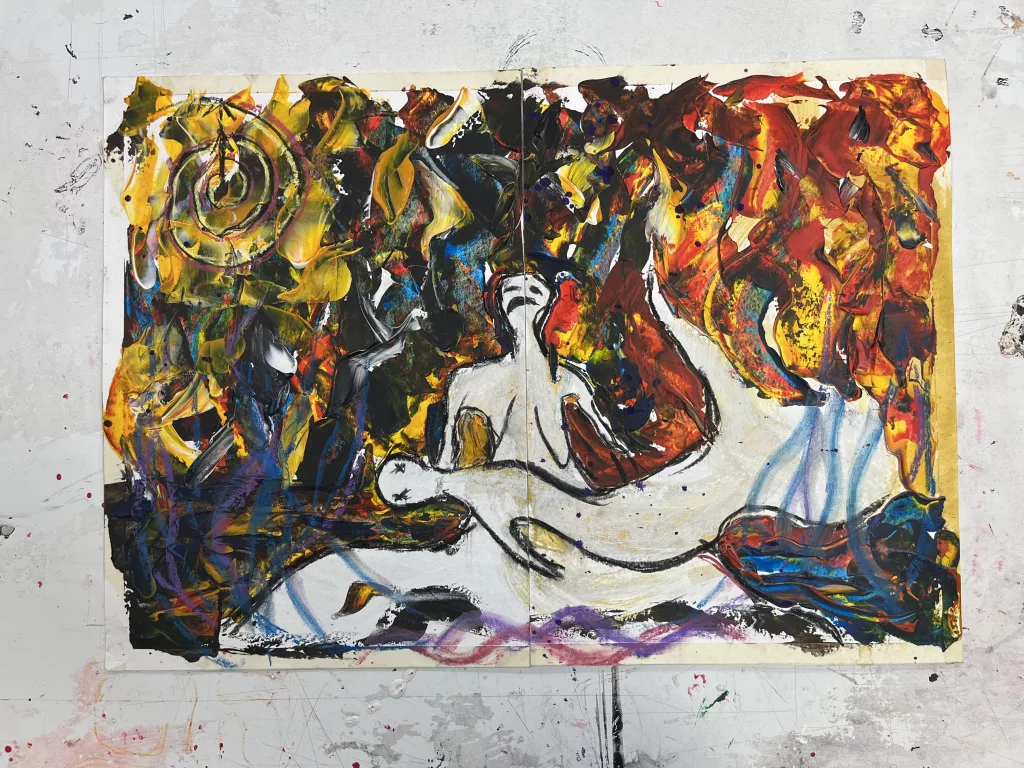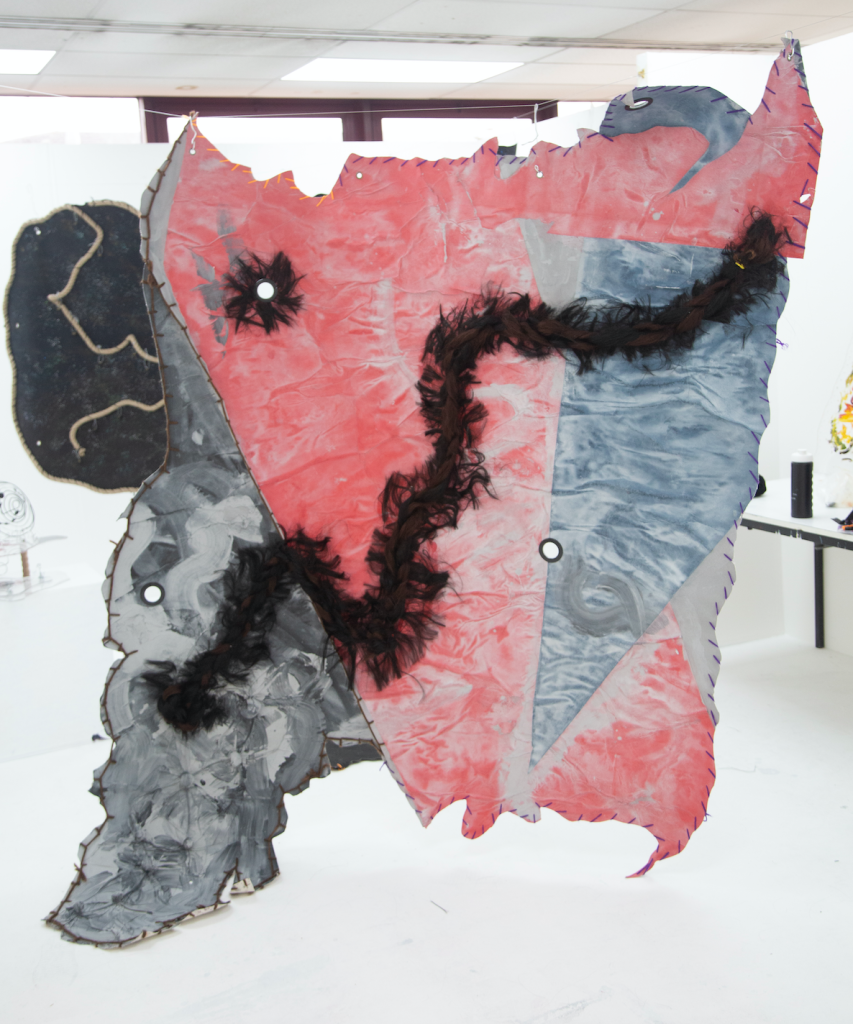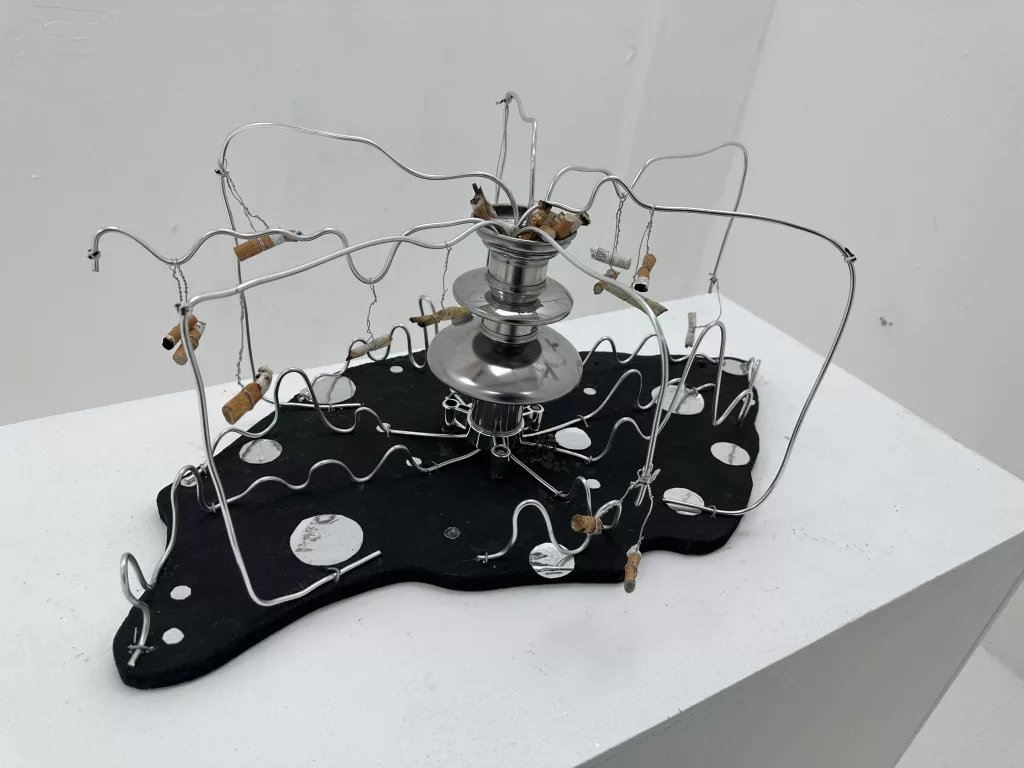
Favour Agumadu is a mixed media creator. He identifies as a messenger in the context of his ideas, and he carries himself as an artist’s artist. Favour digs deep in his works— for material and for inspiration. His journey, catalogue and insights speak for him, and what results when these factors are interrogated is an exciting story about what it means to answer the call of an artist. To stand in as a Prophet, or mediator, and navigate a world that refuses to value visual storytelling, or history of any kind.
Favour’s family in the early days were not inclined to the arts, but his uncle and cousin were. During christmas holidays when they will travel to spend time with extended family in the village, Favour would snoop through the rooms and find his Uncle’s figure drawings in an old wooden box. “I would look at his abstract paintings in the old living room covered with dust and strings of cobwebs would drag the paintings with me whenever I went to unhang them.” He shares with The Blotted.
In school, he would draw characters from his favourite cartoons and show them off amongst his friends. His parents supported him at this stage but would raise a brow when Favour would spend most of his time drawing, neglecting other aspects of academic and career path. And even with the affinity, and dexterity he showed towards the arts and craft– Favour himself remained unsure about this journey due to personal experiences. “I really liked art but I was afraid and was discouraged by the local artists I saw because they were not of a strong financial status in the society.”
Even through challenges at home, and immediate environment, his teachers encouraged him to do more art because it set him apart from his peers. Favour found a sense of identity, and purpose practicing, and sharpening his skills. He began to dig deep and explore art history, finding other practitioners that had done things in exemplary ways.
Here, he learns about Leonardo Da Vinci, painter, inventor and engineer who took a solutionist, and barrier breaking approach to his art. Da Vinci was the first person to create detailed outlines of cities. He was also the first person to visually represent human anatomy, offering detailed drawings of organs, teeth and nerve function that not only revealed information about medicine, but were also used in medical school till photo technology came about.
There is a parallel between Leonardo Da Vinci and Favour’s story as well, because in Primary School, the young artist was selected to contribute teaching material for his seniors. “My artistic ability didn’t go unnoticed even in primary school. I remember being called by one of my teachers in primary school to draw a skeleton for my seniors on cardboard that they would use to learn.” Favour said.

Grief Series (2022)
Favour Agumadu’s art emerges across different mediums, and multiple styles– but the concepts remain symbolic and surrealist. The works carry abstract themes desperate to be communicated. He sculpts a person’s hand reaching out, trying to grasp something from beyond what seems like the grave. Another painting is a tree with a human heart for root, another personifies how man is immersed into another world when he reads. Favour’s work isn’t grounded in reality, it thrives on ideas.
The artist’s style evolved over the years, with perspectives shifting according to works that inspire him. Favour draws from Abiodun Olaku and Njideka Akunyili Crosby’s works in his conventional paintings and portrayal of elements. However, his recent works show him stepping outside of flat wooden canvases to stitching different elements together like El Anatsui and Prof. Ozioma Onuzulike.
He has gone on to create set pieces with mixed media that exist as objects removed from frames. “Tracy Emin has a strong influence on my works as her works made me look at art from a different perspective other than what I could see.” He continues, “Her interpretation of works especially My Bed (1998) made me question the traditional understanding I knew as art.”
One of his projects, Origin Series, explores the Nigerian Igbos (East). He uses numerous materials like paper, glitters, eyelets, grommets, yarn, jute rope and hair to weave together effigies that allude to the spirit world, Nigerian civil war, and the famous Ukwu Uccor tree in Umudagu Mbieri, Imo state.
“This work made me travel back in time over 3 centuries to seek the origin of the Igbo people. Some scholars believe that the Igbos were part of the missing tribe of Israel due to the similarity in culture.” Favour said. “To me it sounds true because my ancestors were fish merchants and travelled a lot but I can’t really stand on the theory.” Some of these cultural stories don’t bring any results when searched online.
Another piece that gained a lot of acclaim was City on the hill (2023) where Favour Agumadu represented 16th century African slaves in Colombia, plaiting their hair as maps to help them escape to safe cities. “I feel a lot of African history was lost during the slave regime; I am working to find them out” He said. This work is mixed media, using canvas, paper, eyelets, grommets, yarn and acrylic to bring to life in 2.5 dimensions.



Favour Agumadu
Title: City on the hill
Medium: Canvas, paper, eyelets, grommets, synthetic hair, yarn and acrylic.
Size: 112” x 71”
Year: 2023
His art appears on conventional, and large canvases, on walls as frescoes, on wide pieces of clothing material. As sculptures and a mishmash of Plastic, aluminium, buttons, oil, wood, mirror card, copper and even cigarette butts. “Recently I started with large photography background papers to be able to have a greater connection with my work during execution.” Favour said.
Favour does not decide on the medium his art will come through till he’s done with the initial sketch. “I see my works now as a living entity I interact and collaborate with so the work can decide which medium or material I use.” He said. “Sometimes the work decides I stitch her, I can’t say no.“ He has gone ahead to incorporate a mixed bag of elements and material into his art.
His Grief series is quite a visually striking representation of the concept, it is colorful, eye-catching. One would assume that grief is dreary and bleak, but Favour’s interpretation, brush strokes and choice of colours has so much rigour and life. Favour Agumadu in turn, refuses to be definite in his answers “We don’t have to decide the emotions we feel from an artwork rather let the artwork tell us subjectively the feeling it passes to us individually. Grief tells us we are humans.”
Favour Agumadu also worked on two pieces, Notes & Feelings where he explores music as an artform. He takes a two-pronged approach to this project. Notes embodies him stepping into the musician’s shoes to retrace, visually the rhythm and moving parts in the song. After that was done, Favour moved on to Feelings where he portrayed music from his own point of view. “Feelings on the other hand is the best way my own mind interprets it subjectively away from what the musician felt.” He said.



Title: Death’s Goblet
Medium: Wood, mirror card, copper and cigarette butt.
Artist: Favour Agumadu C.
Year: ©2023
Favour is curious– always finding, questioning, quizzing, yearning. Always investing in things that the world can benefit from and this circles back to how art in its purest form is giving away a part of yourself so the world can learn about itself better. The artist also shows interest in the financial viability of being an artist in Nigeria— a topic that The Blotted has also talked about extensively. On his Youtube channel, he interviewed Onyekachi Opara Courage to share his thoughts on building a sustainable art market for the individual, and the community at large. They outline strategies one can take to platform art and make sales.
“I have come to a questionable conclusion that there is financial freedom in art if you get the right direction. There is no particular way to gain financial independence in art. You just have to study the system or market and break the rules. Creating art and The business of art are highly different. Once you understand and learn both, you’ll make it in the business of art.” Favour said, and this outlook applies to any creative endeavour in Nigeria.
The artist, Favour Agumadu remains tentative, thinking, feeling, creating– driven by freedom and destiny. He aspires to elevate human consciousness, and mindfulness through his works. And he strongly holds a belief that this is what he is meant to do, and the time he has been given is limited. His plans entail him exhibiting his Origin series in the near future.
Read more reviews and pieces about culture and art on The Blotted. Follow us on Twitter and Instagram @onetinyblot


NO COMMENTS